Fun fact: on average, desktop users donate nearly 50% more than mobile users. And that’s just one of the many eye-opening statistics we’ve learned about nonprofit marketing.
At WPBeginner, we have helped lots of nonprofits improve their online presence to successfully promote their causes. Many of our WordPress businesses even offer special discounts for nonprofit organizations.
That being said, we know that nonprofits need more than just tools. They need insights, strategies, and data to make the most out of their limited resources.
That’s why we’ve put together this big list of nonprofit marketing statistics and insights. Whether you run a small local charity or a large international organization, you’ll learn where to focus your efforts and how to grow your impact.
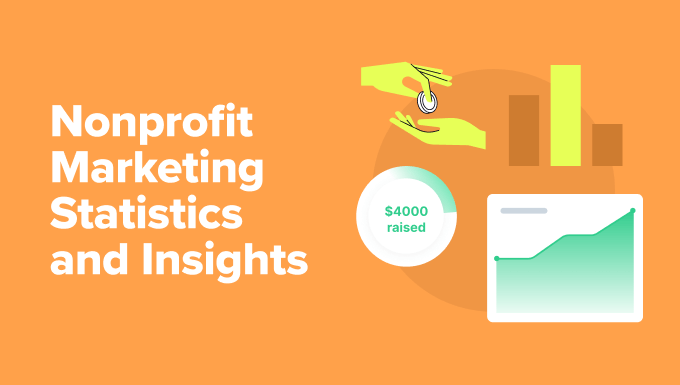
Key Nonprofit Marketing Statistics
We’ve found a lot of fun facts and data about the nonprofit marketing industry. To make it easier, we’ve categorized them into several topics, and you can use the quick links below to skip to the one you want to read the most:
- An Overview of the Nonprofit Marketing Landscape
- Top Digital Marketing Channels for Nonprofits
- Donor Behavior and Giving Statistics
- Nonprofit Website Statistics You Must Know
- How Social Media Compels Donors to Take Action
- Preferred Donation Payment Methods
- Nonprofit Communication and Content Marketing Strategy
- Emerging Nonprofit Marketing Tech Trends
An Overview of the Nonprofit Marketing Landscape
The nonprofit world is constantly evolving, and understanding the latest trends can help your organization thrive. Let’s look at some key statistics that show the current state of nonprofit marketing and fundraising.
1. For every $1 raised online, nonprofits collected $0.94 through direct mail.
This difference shows that online fundraising is slightly more effective than traditional methods. It’s a clear sign that having a strong online presence can give your nonprofit an edge in today’s digital world.
However, the fundraising landscape remains competitive, and you’ll quickly see why.
2. Out of every 1,000 fundraising messages sent, nonprofits only manage to generate $78 in donations.
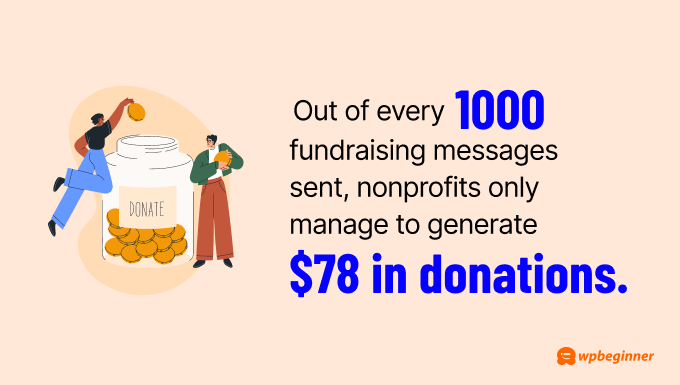
This low return highlights how challenging it can be to capture donors’ attention and convince them to give. It’s a reminder that every message counts and nonprofits need to work hard to stand out in a crowded field.
So, how can you boost your online fundraising efforts? If you’re using WordPress for your nonprofit website, you’ll need a handy donation plugin like WP Charitable.
Charitable is an all-in-one WordPress donation plugin trusted by over 10,000 organizations, including us. In fact, it’s what our founder, Syed Balkhi, uses to collect donations for the Balkhi Foundation.
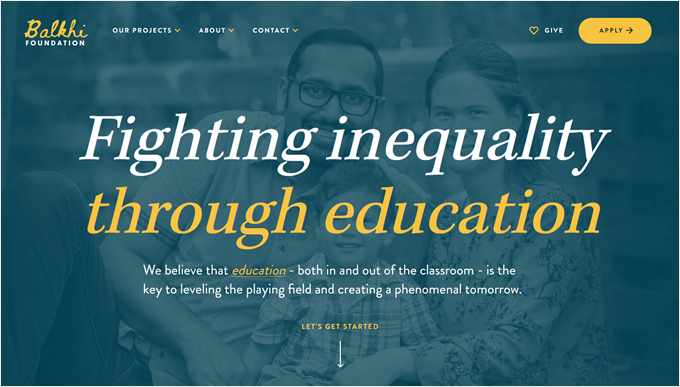
It includes features like customizable donation forms, pre-made donation pages, recurring donations, and donor management tools. Because of these, we’ve been able to create conversion-optimized campaigns that help raise money for causes that we care about.
You’ll learn more about the plugin as we go through this ultimate list of nonprofit statistics. But if you want a more in-depth look, check out our Charitable review.
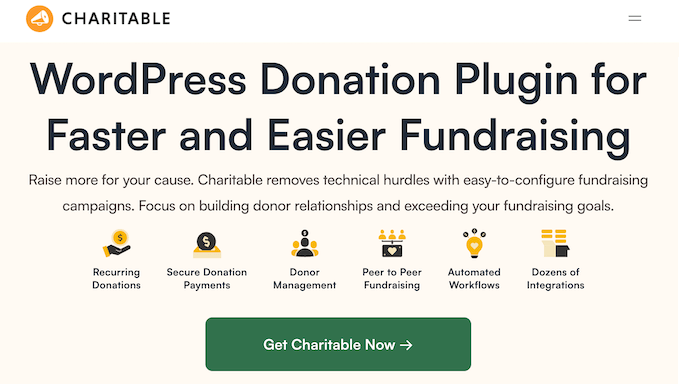
3. Matching gift programs generate $2-3 billion in donations annually.
Matching gift programs are initiatives where employers match their employees’ donations to nonprofits.
These programs are popular because they allow donors to increase their support without spending more of their own money. At the same time, they can also encourage corporate social responsibility.
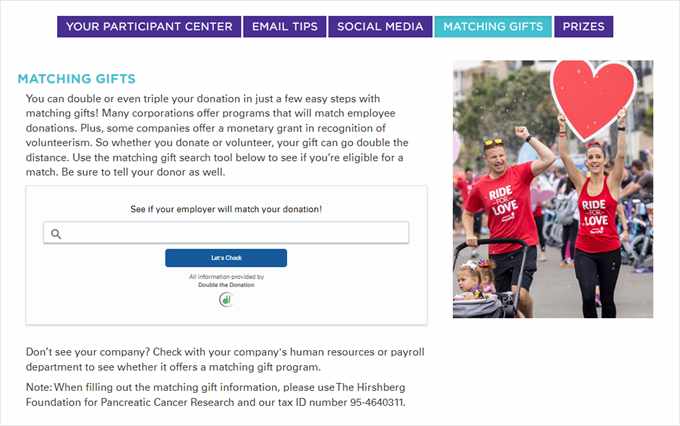
If you want to take advantage of matching gift programs, then you can use tools like Double the Donation. This platform can help donors quickly check if their employer offers matching gifts.
If they do, then the donor will usually fill out a form to submit to their employer, potentially doubling their contribution to your nonprofit.
4. 46% of nonprofits report their highest ROI from events, yet only 4% of donors say they’d give again to the same nonprofit after attending an event.
Events can drive donation volume, but without ongoing engagement, donors might not stick around.
This is where a well-rounded nonprofit marketing strategy comes into play. By balancing in-person events with digital marketing efforts, nonprofits can more easily retain donors.
5. Cultural nonprofit organizations generate 53% of their online revenue from memberships, while public media rely on memberships for 100% of their online income.
In other words, a lot of people are willing to become paid members of a nonprofit organization they care about.
Nonprofit memberships typically offer supporters exclusive benefits in exchange for regular financial contributions.
For example, a news organization might provide members with ad-free access to all articles, exclusive in-depth investigative reports, and invitations to Q&A sessions with journalists.
This model can be beneficial beyond one-time donations as it creates a steady income stream and promotes a deeper connection with supporters.
To implement a membership system for your nonprofit website, consider using a plugin like MemberPress. We used MemberPress to create our video membership site at WPBeginner, but it’s also flexible enough for various nonprofit needs.
You can use it to set up paid memberships, create paywalled content, or offer tiered membership levels with different benefits.
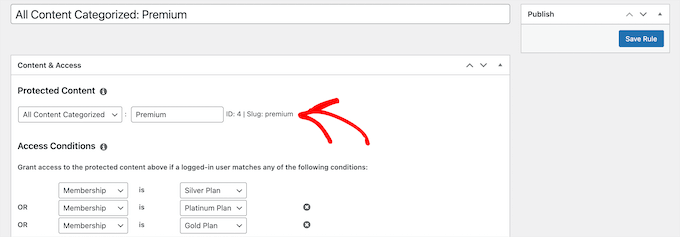
What’s more, MemberPress offers special nonprofit pricing plans for qualifying organizations. For example, the basic plan normally costs $359 per year, but nonprofit organizations can get it for $179.50 per year.
For more information, check out our MemberPress review.
More General Nonprofit Marketing Stats
- 49% of nonprofits think events are a top method for staying in touch, but only 4.3% of donors agree.
- The majority of charitable dollars in the United States go to religion (27%), human services (14%), education (13%), grantmaking foundations (11%), and health (10%).
- 60% of nonprofit marketers cite staffing constraints as a major issue in their work.
- 42% of nonprofit marketers struggle with adapting to changing consumer behavior.
- 65% of nonprofit organizations have an annual marketing budget of less than $100,000.
- 73% of nonprofit marketers are prioritizing donor acquisition.
- 59% of nonprofits are focusing on raising awareness with their marketing.
- 46% of nonprofit marketers are prioritizing events.
- 44% of nonprofit organizations prioritize retaining existing donors through their marketing.
- Revenue from one-time giving fell by 5% in 2024, but revenue from monthly giving rose by 6%.
- Monthly giving accounts for 31% of all online revenue for nonprofits.
Top Digital Marketing Channels for Nonprofits
This section explores the most effective digital channels to achieve nonprofit fundraising success.
6. Email marketing (26%) and social media (25%) get the most donations, while other media generate 12% of donations.
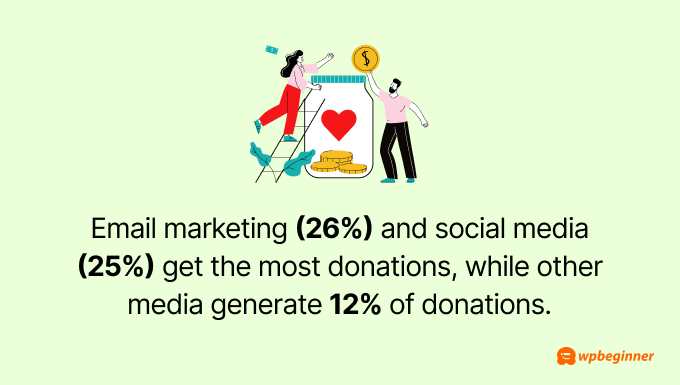
These nonprofit fundraising statistics show how powerful direct communication can be. Email and social media let nonprofits share personal stories and connect with supporters, which can boost online donations.
To improve your nonprofit email marketing, avoid common mistakes by reading our article on email marketing mistakes WordPress users must avoid.
If you already have a website, then it’s a good idea to show your social media presence there. Try using Smash Balloon, a social media feed plugin, to display your latest posts from Facebook, Instagram, and more and build your credibility as a nonprofit organization.
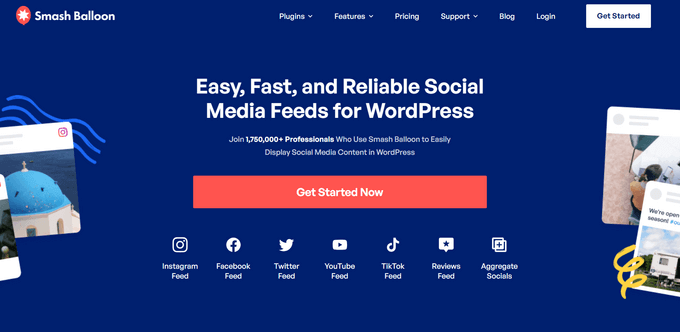
Smash Balloon also offers a discount to nonprofit organizations. You just need to contact them here and send them your nonprofit ID, a link to your website, and your position.
7. Search ads have the best ROI, earning $3.72 for every dollar spent, while display and social media ads only generate $0.59 and $0.57, respectively.
Search ads can catch potential donors when they’re actively seeking ways to support causes, increasing the chances of donation. This makes sense, as people searching for specific charities or causes are likely more ready to give than those who simply see an ad while browsing.
To get the most from search ads, you need a good landing page. You don’t want potential donors to click on your ad only to arrive at a page that looks different from what they expected or doesn’t clearly guide them to donate.
For this, we recommend using SeedProd. This is what we use to create our landing pages and coming soon pages for upcoming projects. Our friends at OptinMonster also use it for their own campaigns, and they managed to increase their conversion rate by a whopping 340%.
You can learn more about the platform in our SeedProd review and our helpful guide on how to create a Google ad landing page that converts.
Here’s an example of a nonprofit landing page template by SeedProd:
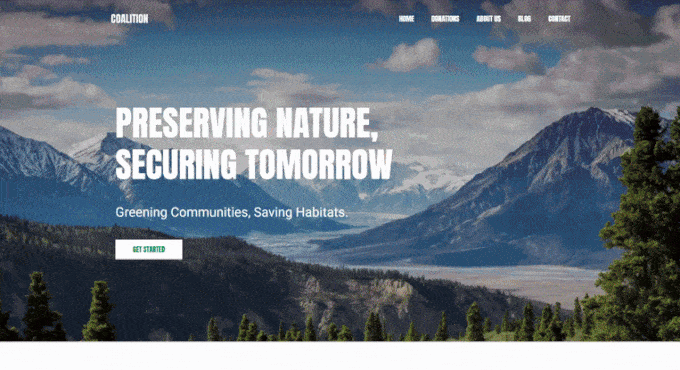
8. 63% of nonprofits plan to invest more in video marketing to promote their causes.
With videos, users can see the real impact of their donations, hear from people who have been helped, and connect emotionally with your cause. This visual storytelling can be much more engaging than text alone.
And with the rise of TikTok, YouTube Shorts, and Instagram Reels, you have plenty of opportunities to grab attention with short-form video content that doesn’t need a lot of production value.
Its content discovery algorithm also increases the chances of your message reaching a wider, more relevant audience. So getting eyeballs on your cause becomes easier, even with limited resources.
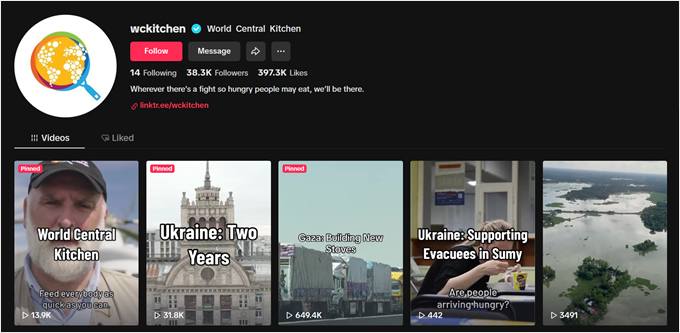
You can also use videos on your website to enhance your nonprofit’s online presence. This approach can be particularly effective for showcasing your mission, sharing testimonials, or highlighting successful projects.
For example, the social venture TeachAids uses a fullscreen video background on their homepage to grab their visitors’ attention.
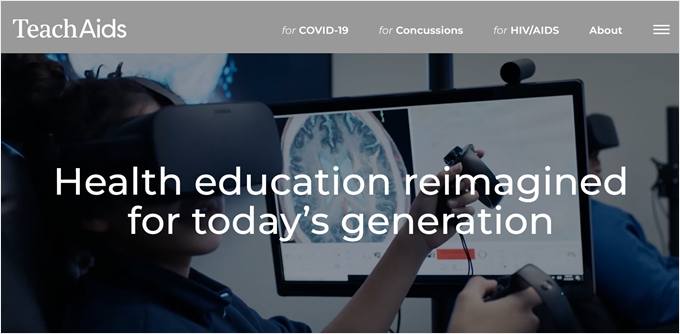
9. Nonprofits measure marketing success mainly through engagement metrics (32%), ROI (25%), and click-through rates (18%).
These metrics help you understand what’s working, what’s not, and where to focus your efforts for maximum fundraising success.
One of the best tools for tracking these metrics is Google Analytics. It provides valuable insights into your website traffic, user behavior, and conversion rates.
To make Google Analytics even more powerful and user-friendly, many WordPress-based nonprofit sites use MonsterInsights, a plugin that simplifies data analysis. It’s also what we use to track the performance of our own websites.
MonsterInsights can help you track donation button clicks, monitor form completions, see which content drives the most engagement, understand your audience demographics, and more. This way, you can base your decisions on data, not guesses.
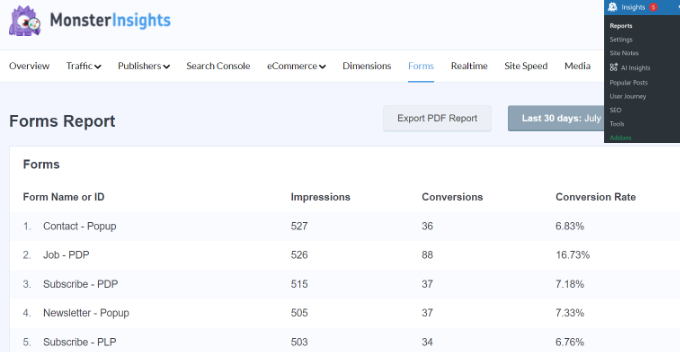
On top of that, qualifying nonprofit organizations may be eligible for MonsterInsights nonprofit pricing. You can get a yearly subscription to MonsterInsights Plus for $69.65 per year (the normal price is $99.60 per year).
For a detailed look at how MonsterInsights can boost your nonprofit marketing efforts, check out our MonsterInsights review.
More Facts About Nonprofit Digital Marketing Channels
- 82% of nonprofits find email to be one of the most effective digital channels for reaching supporters.
- 71% of nonprofits consider Facebook and Instagram the most effective digital marketing channels.
- 33% of nonprofits see peer-to-peer fundraising as one of their most effective digital channels.
- The average cost per click for digital ads varies: $2.99 for social media, $3.68 for video, and $3.72 for search advertising.
- Digital advertising investment is growing, with overall nonprofit ad spending increasing by 12%.
- Paid social media advertising has seen a dramatic 102% increase in investment by nonprofits.
- Email-based marketing and promotional campaigns generate 28% of all online nonprofit revenue.
Donor Behavior and Giving Statistics
Understanding donor behavior is important for creating an effective nonprofit marketing strategy. Let’s dive into some key statistics that can shape your fundraising approach.
10. A compelling reason can motivate 74% of donors to increase their donation amount or give outside their regular schedule.
To make your reasoning compelling, focus on storytelling that shows the direct impact of donations and creates an emotional connection.
A great example is the content shared by EB Research Partnership on Instagram. This nonprofit organization often posts on Instagram about what life looks like for children with the Epidermolysis Bullosa (EB) disease.
This approach puts a face to the cause, helping donors understand the real-world impact of their contributions. By sharing personal stories and vivid imagery, EB Research Partnership creates an emotional connection that motivates donors to give more generously.
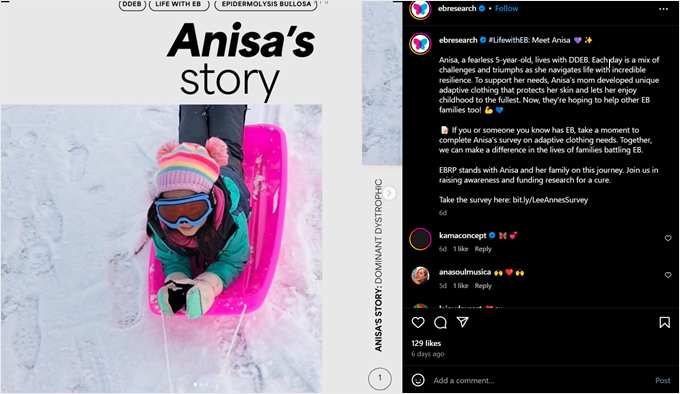
11. 75% of donors look for information about a charity’s accomplishments before deciding to give.
People want to know that their contributions will make a real difference. Seeing concrete achievements helps build trust and confidence in the charity’s effectiveness.
To address this need, you can display social proof on your website. This can include testimonials, case studies, and trust badges that showcase your organization’s impact and credibility.
Here’s a great example by Pencils of Promise, which uses a number count animation to showcase the impact of their community:
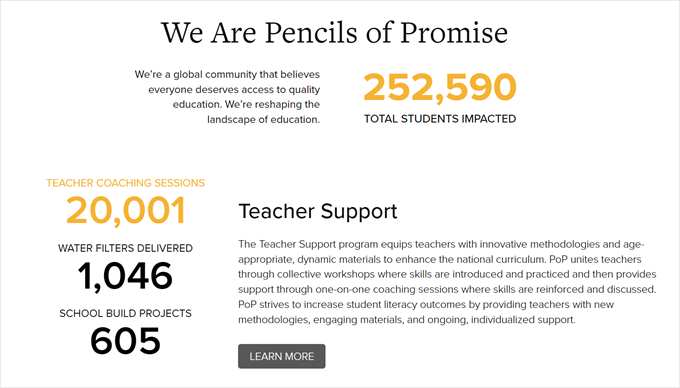
To learn more, check out our article on how to create a reviews page in WordPress and our guide to the best social proof plugins.
12. Donation conversion rates double on Giving Tuesday and New Year’s Eve compared to other times of the year.
This spike likely happens because people feel more generous during the holiday season and are motivated by year-end tax deductions.
To capitalize on this trend, Charitable comes with a feature to display a fundraising thermometer on your donation form. This will create a sense of urgency and show real-time progress towards your goal.
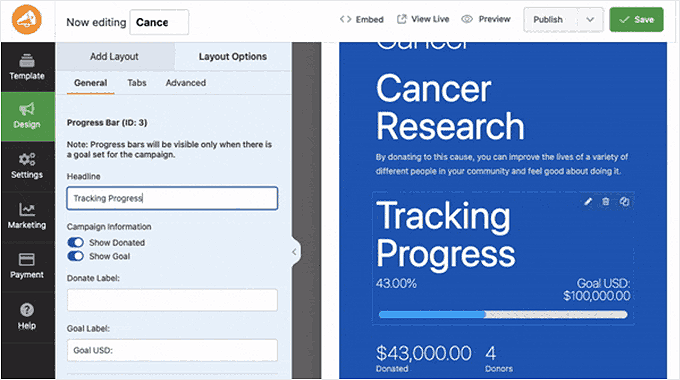
You can read our step-by-step guide on how to create a donation form for nonprofit organizations for hands-on guidance.
13. 15% of donors said they stopped donating when the organization had reached its goal.
Donors often feel a sense of accomplishment when a need is met, which can lead to a decrease in ongoing support.
One way to solve this issue is to set progressive goals instead of a single large one. In other words, you can create a series of smaller, interconnected objectives to maintain your momentum.
For example, instead of making ‘raise money for our school’ as the goal, you can set progressive goals like ‘raise money for the school’s building,’ then for the supplies, and then for other needs like educational programs or technology upgrades.
This approach keeps donors engaged over a longer period and helps them see the ongoing impact of their contributions.
You also want to set up monthly giving plans, which can help maintain a steady income stream. Charitable offers a recurring donations feature that can be particularly useful for this.
With this tool, donors can log into their own accounts to view and manage recurring payments and get a summary of all their donations for the year.
This automated payment system not only makes it easier for donors to contribute regularly but also provides them with easy access to their giving history.
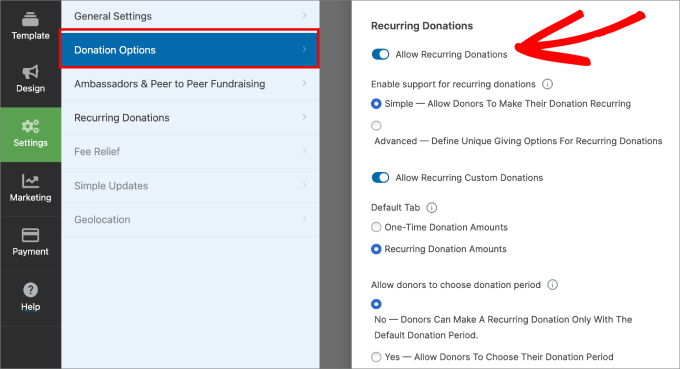
More Data About Donor Behaviors
- Most people support one to three charities, with 36% giving to two, 24% to one, and 21% to three.
- 50% of donors would likely donate if asked unexpectedly by email.
- 33% of people stop donating when their expendable income changes.
- 24% of people who currently donate would switch to another charity if they liked it more.
- Donations spike in November and December for both new and regular donors.
- Large donations over $5,000 happen more often at the end of the year.
- For regular donors, 94% choose monthly donations, 3% weekly, 2% yearly, and 1% every three months.
- Gen Z and Gen X donors prefer donating through mobile apps, Facebook, social media, and texts.
- Boomers and Gen X donors like to hear from charities every few months or once a year, not monthly or weekly.
- On average, most donations happen on Tuesdays at 10 am, with the busiest time being 9-11 am in the donor’s time zone.
- Regular donors are most likely to stop their donations in January.
Nonprofit Website Statistics You Must Know
These website statistics provide valuable insights for nonprofits looking to optimize their online presence.
14. WordPress.org is the top content management system for nonprofit websites (58%), compared to 7% using Wix, 6% using Squarespace, and 5% using Drupal.
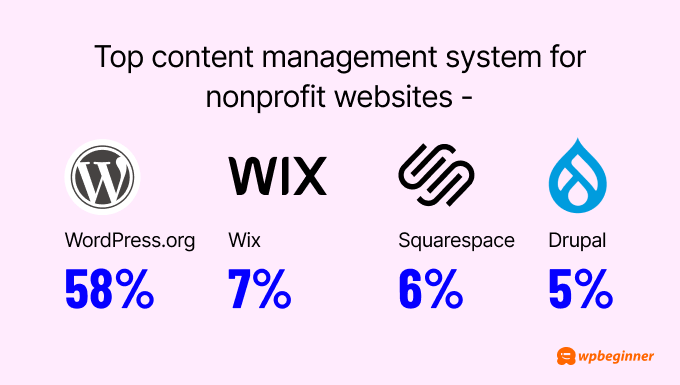
With WordPress powering over 43% of all websites on the internet, this makes sense.
Unlike other website builders like Wix or Squarespace, WordPress.org requires purchasing your own hosting. That being said, it still offers an unbeatable combination of ease of use, customizability, and extensibility.
The reason is that you can pick and choose your own nonprofit WordPress plugins to create a website that perfectly caters to your needs.
What’s more, setting up a WordPress.org site has become even easier thanks to hosting providers like Bluehost, which offers one-click WordPress installation. This feature significantly speeds up the setup, especially for those without technical experience.

Plus, WPBeginner readers can get up to 70% off of their first hosting purchase with our exclusive Bluehost discount.
You can claim it by clicking on the button below:
15. 75% of nonprofits choose to use a .org domain for their primary website and email communications.
The .org domain stands for ‘organization.’ It is popular among nonprofits because it immediately signals to visitors that the website belongs to a mission-driven entity rather than a commercial company.
This choice can help build trust and credibility with potential donors and supporters, as it aligns with the nonprofit sector’s values and purposes.
If you’re in the market for a .org domain, we recommend checking out Network Solutions. They offer competitive pricing and include domain privacy protection, which helps keep your personal information secure from public view.
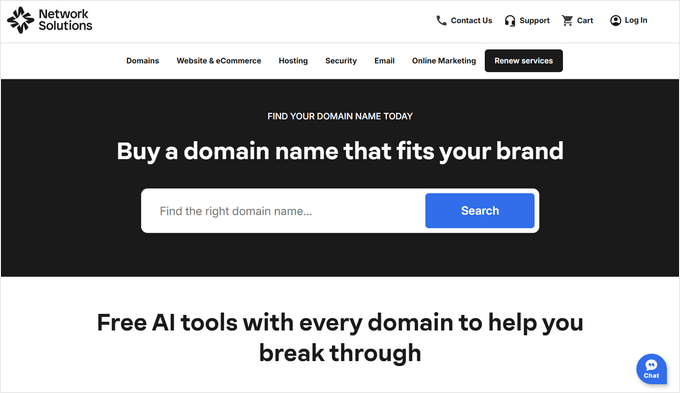
Another option to consider is bundling your domain with your hosting service. Providers like Bluehost and Hostinger often include domain registration in their hosting packages, even offering the domain for free.
It’s an excellent way for nonprofits to simplify their website setup while potentially saving on costs.
16. Gen X donors cite an outdated website as the top reason for not donating to an organization.
An outdated website can suggest that an organization is not keeping up with current trends or technologies. This might make potential donors question the nonprofit’s credibility and legitimacy.
If you’re concerned about the state of your nonprofit’s website, then check out our beginner’s guide on how to redesign your WordPress website.
17. Desktop users give the largest average donations at $118, followed by tablet users at $96 and mobile users at $79.
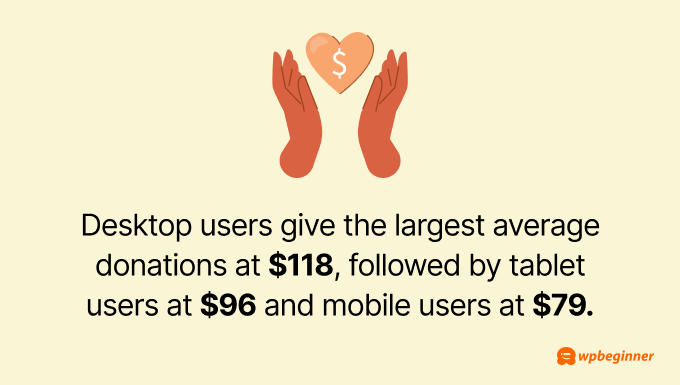
Desktop users often have a more comfortable browsing experience, which can lead to longer engagement and potentially larger donations. They may also be more likely to be at home or work, where they feel more secure making larger transactions.
Mobile users, on the other hand, might be on the go and more inclined to make quick, smaller donations.
This data highlights the importance of having a mobile-friendly website for your nonprofit.
First, you need a responsive nonprofit theme that automatically adjusts its layout and content to fit different screen sizes, from mobile to desktop.
Secondly, you need a donation form that works well on small screens. Thankfully, Charitable comes with templates that look good on all devices.
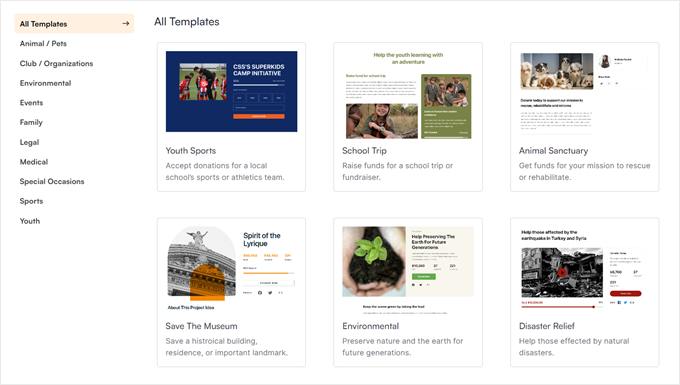
Alternatively, you can use WPForms to accept donations.
This form builder plugin has tons of donation form templates for specific use cases, from fundraiser registrations to Girl Scout Cookie orders, crowdfunding, volunteer applications, and so much more.
And the good news is that WPForms offers a special nonprofit discount. You can get WPForms Pro at $99 per year, which is 75% off of its normal pricing.
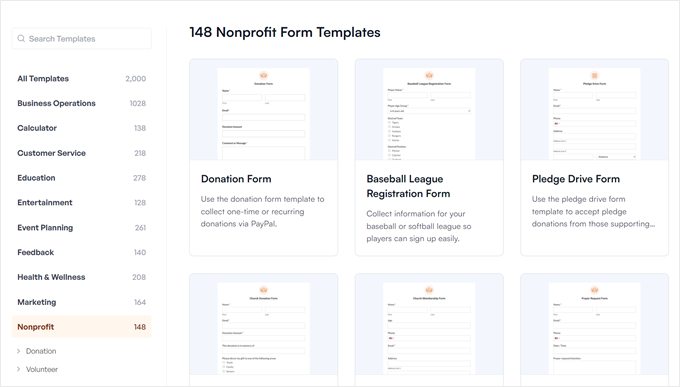
If you want to see the plugin in action, then you can check out our in-depth WPForms review.
18. 27% of nonprofits worldwide have fallen victim to cyberattacks.
As nonprofits increasingly rely on digital platforms for fundraising and donor engagement, they become attractive targets for cybercriminals looking for sensitive data or to disrupt operations.
It’s important to focus on cybersecurity in your nonprofit marketing strategy to protect your nonprofit’s online assets and hold onto donor trust. This includes safeguarding your website, donor databases, and email systems.
We recommend using a security plugin like Cloudflare, which we use at WPBeginner. It has improved our page load times, enhanced security, and overall website stability.
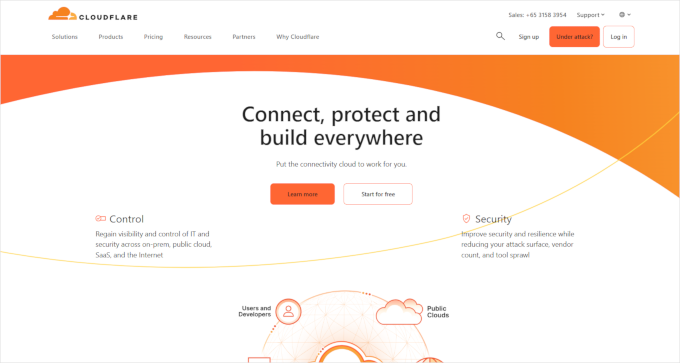
More Nonprofit Website Statistics
- 75% of nonprofit website revenue comes from desktop devices, even though 57% of traffic is from mobile devices.
- Users on desktop devices perform 65% of total transactions on nonprofit websites.
- Nonprofit websites have an average bounce rate of 60-70%.
- 68% of online donors trust websites and email addresses that use the .org domain more than other domain extensions.
- 68% of nonprofits have a website security plan in place.
- 84% of nonprofits have an SSL certificate for their website.
- 38% of nonprofit marketers are planning for a significant website redesign.
- Online donation pages have an average conversion rate of 8% on mobile devices.
- 22% of nonprofits have websites designed for those with visual and hearing disabilities.
- 20% of nonprofits have a website that is available in more than one language.
- 28% of nonprofits use email subscribe popups on their website.
How Social Media Compels Donors to Take Action
Social media platforms play a major role in driving donations for nonprofits. Here’s what the latest statistics reveal:
19. Facebook dominates as the top platform for social media donations (48%), compared to 24% on Instagram and less than 10% on other platforms.
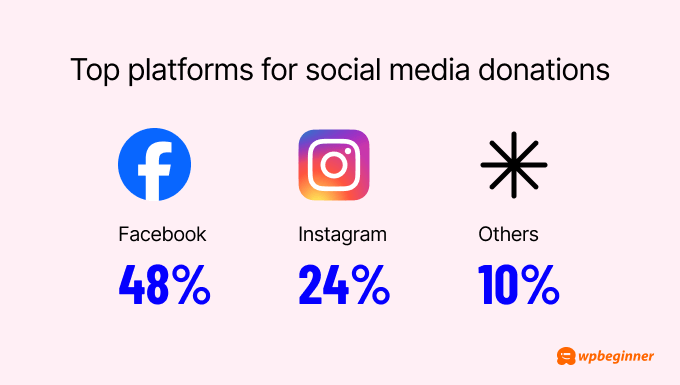
Facebook’s success in driving donations is likely due to its large, diverse user base.
However, it’s important to note that these statistics may not apply universally. Your organization’s ideal platform depends on your specific audience.
For instance, if your nonprofit focuses on issues among younger generations, then Instagram or TikTok might have better results.
A great example is To Write Love on Her Arms, a nonprofit movement that focuses on mental health. Since the issue is quite popular among younger audiences, it has a large following on Instagram.
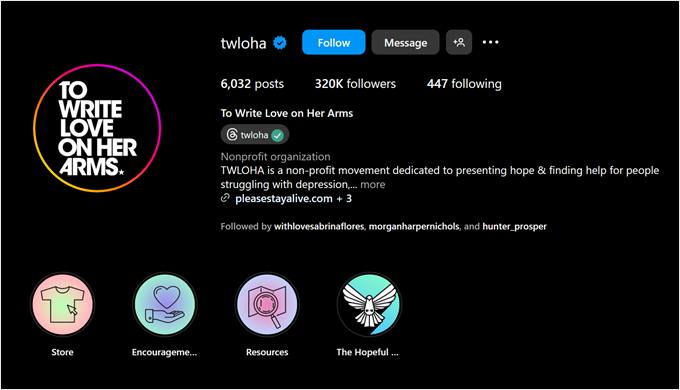
20. TikTok audiences for nonprofits surged by 112% in 2024, far outpacing Facebook (6%) and Instagram (11%), while Twitter/X saw a slight decline of 1% in follower counts.
TikTok’s rapid growth can be linked to its popularity among younger users and its algorithm that supports new content discovery.
If it makes sense for your nonprofit organization, then consider creating a TikTok account to build awareness for your causes.
Once you start creating content, you may also want to embed TikTok videos on your WordPress site using Smash Balloon. Doing this can let your audience know about your TikTok presence and increase your followers.
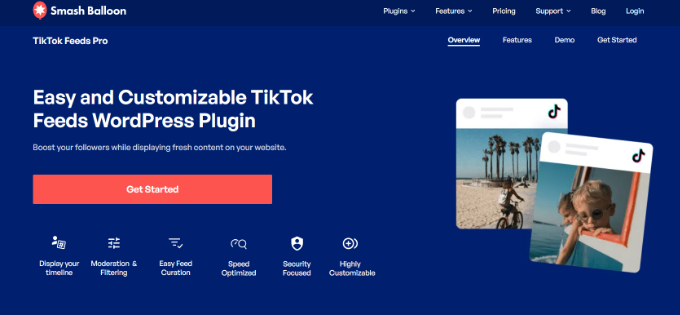
21. Nonprofits with paid influencer campaigns used these partnerships for education or persuasion (79%), advocacy or volunteer recruitment (75%), and fundraising (50%).
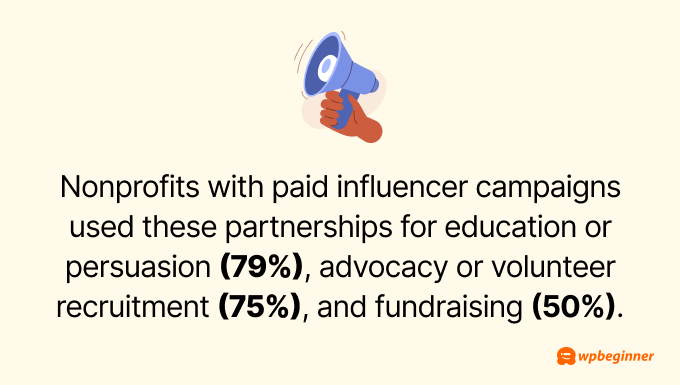
Influencers, content creators, and public figures can be powerful allies in nonprofit marketing strategies. They bring their established audience and credibility to your cause, potentially reaching new donors and supporters.
However, the key to success lies in choosing the right influencer and crafting a campaign that feels authentic to both the influencer and your nonprofit’s mission.
A great example of this is actress Florence Pugh’s collaboration with Racing Dementia. She likes to make cooking videos, and for this campaign, she hosted a special ‘Cooking With Flo’ segment to talk about dementia.

The content uses her personal, engaging style to introduce a serious topic and combines entertainment with education about the cause.
As a result, Pugh’s followers learn about Racing Dementia in a way that feels natural and engaging, potentially increasing support for the nonprofit.
22. LinkedIn has the highest average conversion rate for donations among social media platforms (30% on mobile and 50% on desktop).
This high conversion rate on LinkedIn is likely due to its professional audience, which is often more financially stable and inclined to support causes.
To effectively market your nonprofit cause on LinkedIn, you can post regularly about how your organization is making a difference, using real-life infographics and data.
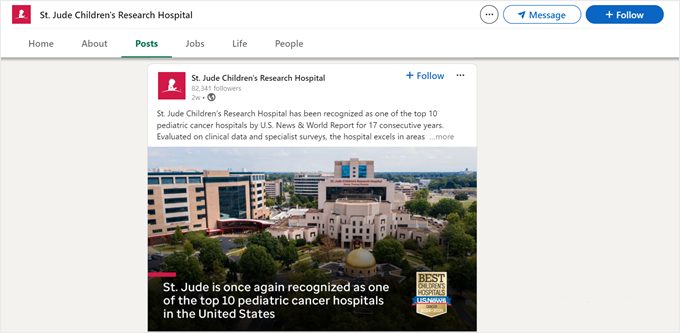
LinkedIn users love content that combines professional insights with personal stories. So, don’t be afraid to share the human side of your nonprofit’s work alongside impact statistics.
You will also want to encourage your team members to repost your content with their professional networks. This way, you’re not just relying on your organization’s page for reach. When employees share your content, it appears more authentic and can reach a wider audience.
More Nonprofit Social Media Content Marketing Trends
- TikTok users have donated $7 million directly to charities through the app.
- Facebook accounts for 83% of social media traffic to nonprofit campaigns, followed by Instagram at 11% and YouTube at 3%.
- Instagram’s donation conversion rates are 30% on desktop and 20% on mobile.
- Facebook converts donors at 23% on desktop and 14% on mobile.
- YouTube has the lowest donation conversion rates at 13% on desktop and 6% on mobile.
- 25% of nonprofits have stopped posting on Twitter/X but still have their account.
- 8% of nonprofits have deleted their Twitter/X account.
- 15% of nonprofits rarely use Twitter/X.
Preferred Donation Payment Methods
The nonprofit fundraising statistics below reveal interesting trends in how donors choose to pay for their donations.
23. 55% of users prefer to donate online using their credit or debit cards.
Most people use cards regularly, making them a comfortable choice for online donations. It’s often as simple as entering card details once and then giving them with just a few clicks in the future.
If you use Charitable, then you can accept credit card payments through Stripe or debit cards using the Authorize.net addon.
The plugin ensures sensitive payment details are never stored on your website, protecting donors and your cause.
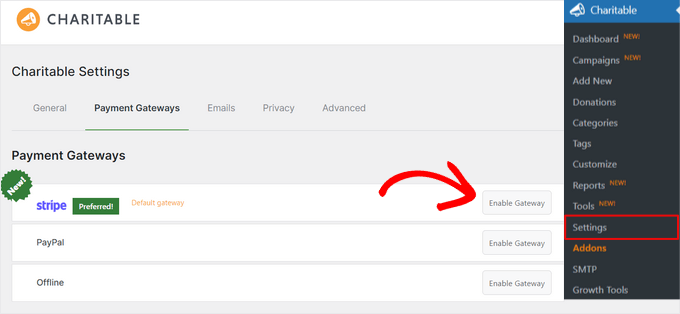
Charitable is also compliant with PCI, GDPR, and CCPA, so your donors’ data is protected according to the latest security and privacy standards. This can give donors peace of mind when supporting your cause.
Want an even simpler way to accept donation payments? Consider WP Simple Pay.
This Stripe payment plugin is perfect if you’re only running a single campaign and don’t need the extra donation features offered by Charitable. Plus, you can set up a pay-what-you-want option to give donors the freedom to donate the amount they can afford.
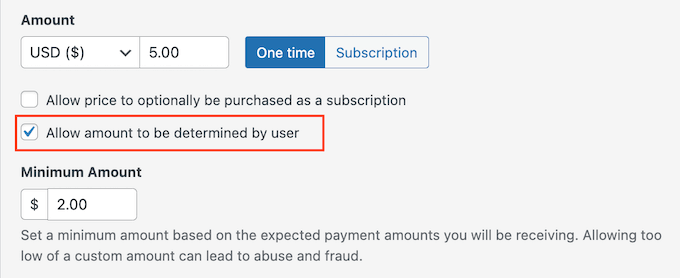
On top of that, qualifying nonprofits are eligible for a 65% discount on a WP Simple Pay license.
If you want to learn more about the plugin, you can read our WP Simple Pay review.
24. The average single donation was nearly 1.5 times larger when nonprofits offered ACH, PayPal, and digital wallet payments.
This increase in donation size might be because these payment methods cater to different donor preferences.
Some people feel more secure using PayPal, while others prefer the convenience of digital wallets. ACH payments can be attractive for larger donations due to lower transaction fees.
Fortunately, Charitable accepts ACH, PayPal, Google Pay, and Apple Pay, among others through its integrated payment methods.
By using Charitable, you can offer your donors a wide range of payment options, potentially increasing both the number and size of donations to your cause.
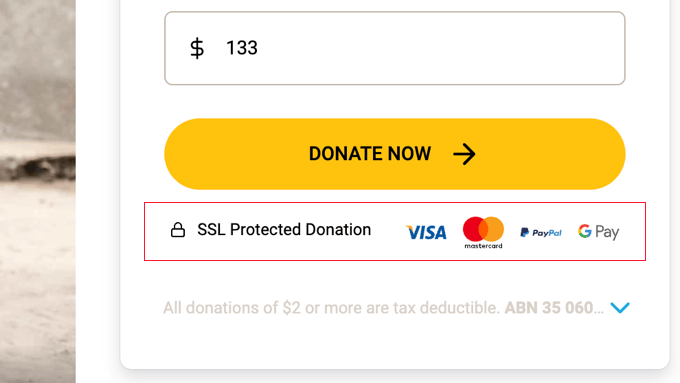
More Trends in Nonprofit Payment Methods
- Direct mail follows credit and debit cards as the preferred donation payment method, at 16%.
- PayPal accounts for 10% of donations.
- Wire transfers make up 5% of donations.
- Cash donations account for 4% of contributions.
- Digital wallets and text-to-give each represent 1% of donations.
- 1 out of 4 nonprofits doesn’t try to re-secure a recurring donation after a credit card number changes, which is a lost opportunity.
- Offering digital wallets can increase mobile conversion rates by up to 14%.
- Recurring gifts through ACH are 55% larger than those made via credit card.
- Monthly recurring donors who give via ACH are retained for 20% longer than those who use debit or credit cards.
Nonprofit Communication and Content Marketing Strategy
Even if you’re using the right tools, your efforts can go to waste without the right communication and content marketing strategy. Here are some key statistics to give you ideas:
25. Personalized emails have 82% higher open rates compared to generic emails.
Personalization is when you tailor your email content to individual recipients. This can include using their name, mentioning past interactions, or segmenting your email list based on donor behavior. People are more likely to open emails that feel relevant to them personally.
To help with personalization, consider using an email marketing tool like Constant Contact.
This platform allows you to add dynamic content to your subject lines, including the contact’s name. If you don’t have their name captured in your database, you can use a fallback option like ‘Friend’ or ‘Valued Member.’
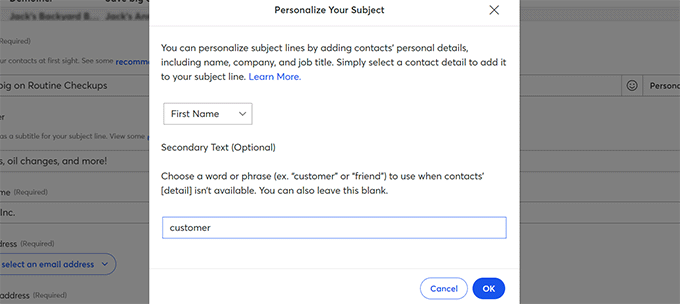
You can learn more about this platform in our Constant Contact review.
26. 58% of donors prefer talking to an individual within the nonprofit organization rather than from the brand itself.
People tend to trust and relate more to other individuals than to faceless organizations. This approach can be particularly effective in email fundraising.
For example, in email campaigns, messages could come from a specific team member rather than a generic organizational email. You can even create a professional email using the team member’s name, like john@nonprofit.com, to add an even more personal touch.
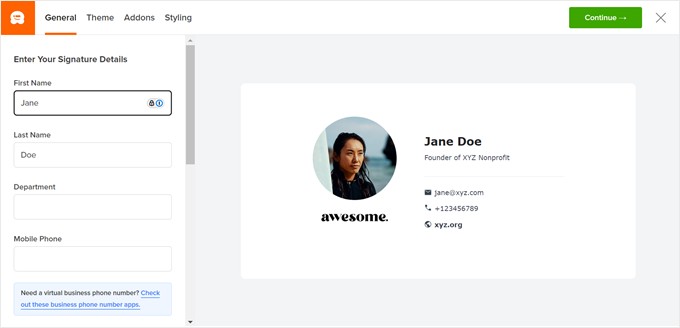
Other than that, you can use our free tool to create a custom, personal email signature. This lets you design a professional email signature that shows off your name, position, and profile picture so that users can see that the email comes from a real person and not a bot.
27. Donors respond best to hopeful messages (41.5%), followed by aspirational (27.3%), fear-based (15.5%), and guilt-based (10.3%) messages.
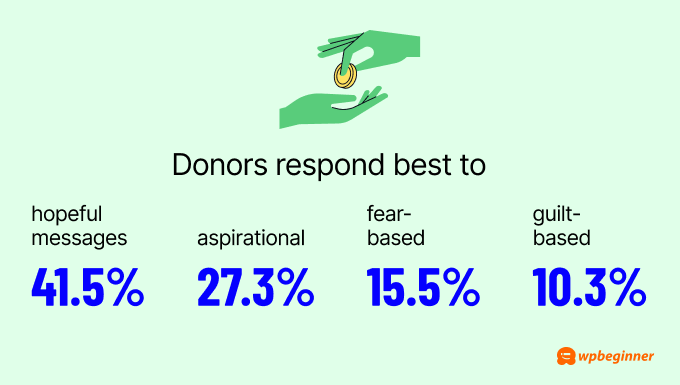
Hopeful and aspirational messages motivate donors by showing them the potential positive impact of their contributions rather than focusing on negative consequences or guilt.
For example, instead of saying, ‘Without your help, children will go hungry’ (fear-based), a more effective message might be, ‘Your donation can help provide nutritious meals to children in need’ (hopeful). This approach emphasizes the solution rather than the problem.
If you’re not sure how to reframe your original copy into a more positive note, consider using an AI writer. These content generators can suggest alternative phrasings, generate ideas for success stories, or help craft compelling calls-to-action that focus on hope and positive impact.
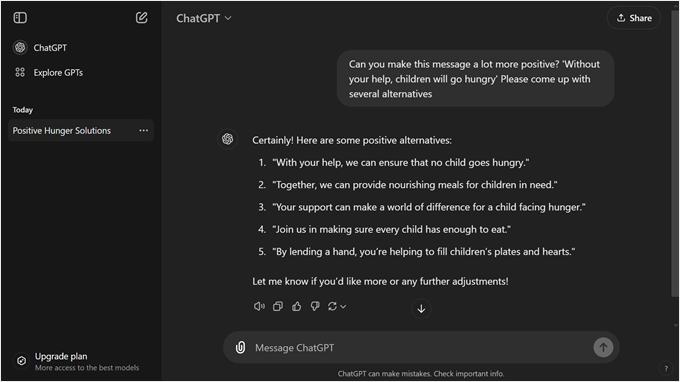
You can read our guide on how to use AI to generate content for more information. But remember, while AI can be a helpful resource, it’s important to personalize the content to make sure it fits your nonprofit’s voice.
28. Digital donation campaigns that use segmentation can increase revenue by up to 760% compared to non-segmented campaigns.
Segmentation means dividing your audience into smaller groups based on specific characteristics or behaviors. This allows you to tailor your messages to each group, making them more relevant and effective.
For effective email segmentation, we recommend Drip, which we use for our own email marketing campaigns at WPBeginner. Drip’s powerful segmentation tools have significantly improved our email marketing results.
With Drip, we can create highly targeted emails based on specific user actions or characteristics. For example, if a subscriber clicks on a particular link in our email, we can tag them as interested in that topic. This allows us to send them more relevant content in the future.
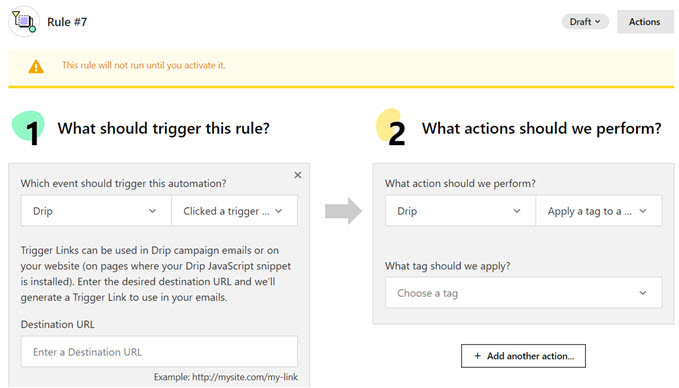
Learn more about this email marketing tool in our piece on why we switched from Mailchimp to Drip.
More Nonprofit Content Marketing and Communication Strategies
- 61% of donors want to hear stories about an organization’s impact and how their services are helping.
- 84% of donors say they’re more likely to donate if a match is offered.
- Studies show that visual progress indicators like fundraising thermometers can increase donations by 15–30%.
- Nonprofits send an average of 3 email newsletters and 2 donation appeals monthly.
- 46% of nonprofits mostly share news, upcoming events, and marketing programs.
- 45% of nonprofits focus on showing how they help.
- 41% of nonprofits focus on optimistic messaging most of the time.
- 30% of nonprofits share inspiring stories regularly.
- 25% of nonprofits frequently display their expertise.
- Only 17% of nonprofits provide motivation most of the time.
- Just 5% of nonprofits say they ask for money on social media most of the time.
- Almost 60% of nonprofits rarely or never post funny content.
- 39% of nonprofits plan to change words or language to better describe their work or programs.
- 31% of nonprofits plan a significant email newsletter template redesign.
Emerging Nonprofit Marketing Tech Trends
Nonprofits are using more tech to raise funds and connect with donors. Here’s what you should know:
29. 67% of nonprofits use customer relationship management (CRM) software to track donations and manage communications.
CRM software helps nonprofits organize donor information and stay in touch easily. It’s great for planning marketing and raising more money.
Take HubSpot CRM, for example. With it, you can gather supporter info through forms, chatbots, social media, and more. Your team can then follow up with potential donors, see how people interact with your nonprofit, and make the donor experience better.
HubSpot gives you a big-picture view of all your marketing efforts, which helps in creating a solid nonprofit marketing plan.
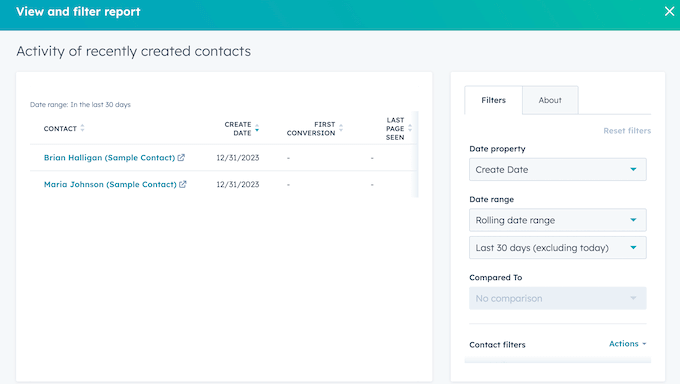
For more information, you can check out our full HubSpot review.
30. 60% of nonprofits are exploring AI but haven’t formalized any policies yet.
This means many nonprofits are interested in using AI for marketing and fundraising, but they haven’t set official rules for it yet. As AI becomes more common in nonprofit tools, it’s important to have guidelines.
When using AI in nonprofit marketing, consider keeping your nonprofit’s unique voice, making sure AI-created content is accurate, using AI to help and not replace human creativity, and protecting donor information when using AI for data analysis.
All these are essential to maintain your donors’ trust.
More Tech Trends in Nonprofit Marketing
- 56% of nonprofits have partially implemented automation tools in some marketing areas.
- 32% of nonprofits are not currently considering AI for marketing efforts.
- 6% of nonprofits are actively investing in AI.
- 53% of nonprofits use generative AI to brainstorm headlines and subject lines.
- 39% of nonprofits use AI to create first drafts of content.
- 34% of nonprofits use AI to improve readability, tone, or style of content.
- 26% of nonprofits use AI to repost content in different communication channels.
- 21% of nonprofits use AI to summarize long documents into shorter articles.
- 14% of nonprofits use AI to optimize content for conversions or other calls to action.
- 11% of nonprofits use AI to develop campaign plans and schedules.
- 8% of nonprofits use AI to draft answers to frequently asked questions.
Sources:
Feathr, Classy, HubSpot, Nonprofit Marketing Guide, Campaign Monitor, Double the Donation, M+R Benchmarks, Nonprofit Tech for Good, Getting Attention, Donor Direct.
We hope this list of nonprofit marketing statistics and insights can help improve your own strategy and promote your cause.
If you want to read more data-driven insights like this one, just check out the articles below:
Learn More Eye-Opening Statistics and Trends
- Internet Usage Statistics and Latest Trends
- Google Search Statistics and Data
- Important Online Payment Statistics, Data, and Trends
- Blogging Statistics, Trends & Data – Ultimate List (UPDATED)
- Mindblowing SEO Statistics and Trends (Ultimate List)
- Affiliate Marketing Statistics You Need to Know
- Impressive eCommerce Statistics You Won’t Believe
- Shopping Cart Abandonment Statistics (Expert Insights)
- Podcasting Statistics You Must Know (Complete Roundup)
If you liked this article, then please subscribe to our YouTube Channel for WordPress video tutorials. You can also find us on Twitter and Facebook.





Navin Rao
An amazing list of stats if you are in the nonprofit world! It is important to note where they are focusing such as, 59% of nonprofits are focusing on raising awareness and 46% on events. This information would guide organizations to better position their marketing strategies to connect and attract potential donors and volunteers.
One statistic that sticks out here is desktop users tend to donate nearly 50% more than mobile users, meaning if we want to optimize our donation pages for each format we should probably put our focus on desktop! You certainly make a solid case for the nuances of nonprofit marketing and, for that, I thank you for sharing all of these data-driven insights!